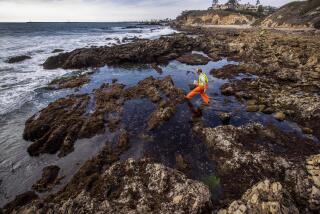Disaster Helps Oil Spill Control Business to Boom
- Share via
ANCHORAGE, Alaska — The Exxon Valdez disaster may prove to be the best thing that ever happened to the oil spill control business.
In the last four years Congress has passed strict new spill preparedness regulations, and by August enough oil skimming and containment equipment should be stationed at 19 spots around the country to corral a spill the size of the Exxon Valdez’s 11 million gallons within 72 hours.
Already, a spill-response company formed by the nation’s major oil companies says it has spent more than $200 million on 16 spill-fighting ships and skimming equipment.
Around the world, governments and oil companies have begun to stockpile the equipment and expertise necessary to limit spill damage, industry observers say.
Regulators and private contractors credit pressure brought on oil companies after the March, 1989, Valdez spill for the added equipment and legislation that demands increased preparedness.
In quick succession, the Alaska Legislature and then Congress approved laws that dramatically strengthened the equipment and training requirements for terminal and tanker operators before the next big spill.
The federal Oil Pollution Act of 1990 calls for tanker and terminal operators to be able to skim 1.68 million gallons of oil a day by the third day of a spill. The act also increased liability limits and called for double-hulled tankers by 2015.
In Alaska, a similar law requires oil companies and tanker operators to be prepared with equipment to keep a spill even a few million gallons greater than the Valdez slick from reaching Prince William Sound’s beaches.
Experts say the port is the best-prepared oil terminal in the world.
Two tugboats now escort all tankers to and from the state’s territorial limits. Nine boats outfitted with oil skimmers, including the 1.268-million-gallon-an-hour skimmer Valdez Star, stand ready. Four warehouses around Prince William Sound house booms, which are floating barriers that can protect the shoreline and absorb oil.
In addition, the Alyeska Pipeline Service Co., which operates the trans-Alaska pipeline and the port at Valdez, has trained the region’s fishing boat operators to deploy booms around oil slicks.
Money plays a part in the varying degrees of readiness, as do political concerns, said Faith Yando, the editor of Oil Spill Intelligence Report, a weekly trade journal.
“I don’t think it’s apathy. I think it has to do with resources,” Yando said.
When the Greek-owned tanker Katina P ran aground five miles off the coast of war-torn Mozambique last April, the government appealed to international authorities to help clean up the million-gallon spill.
“What do you do with a country that has bigger problems than oil spills? Mozambique was in the middle of a civil war at the time,” Yando said.
What the United State has done, and what the International Maritime Organization is moving toward, is to require booms, oil skimmers and trained workers to be available before the next tanker begins leaking.
An IMO agreement signed in 1990 also calls for more international cooperation when big tankers leak. The IMO also is assembling a worldwide inventory of spill cleanup equipment.
Jim O’Brien, a New Orleans-based spill consultant for the past 22 years, said his clients in the Middle East, South America and Europe have begun to stockpile equipment in a way he would not have imagined five years ago.
He pointed to Pemex, the Mexican national oil company, as particularly active in the past several months, having spent about $4 million to purchase spill containment equipment.
But for some, no amount of preparedness can make up for a spill’s impact.
“You really don’t ever clean up an oil spill,” said Bob Sulnick, executive director of the American Oceans Campaign in Santa Monica. “Oil in the marine environment is an absolute disaster.”
Sulnick said that even if an ambitious spill response recaptured 20% of the spilled oil--an amount he called the maximum possible--the rest would leach from sediments for the next 20 years.
Other environmentalists said they’re skeptical the Coast Guard is adequately prepared to coordinate a spill containment even with all the new regulations.
“On the equipment side, they’ve set the levels too low in terms of the amount of equipment that has to be contracted for, and those low limits mean there won’t be enough equipment to clean up a worst-case spill,” said Sarah Chasis, an attorney with the Natural Resources Defense Council in New York.
More to Read
Sign up for Essential California
The most important California stories and recommendations in your inbox every morning.
You may occasionally receive promotional content from the Los Angeles Times.










